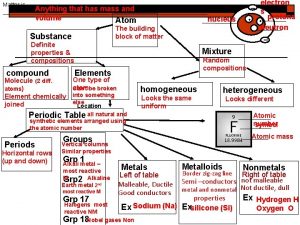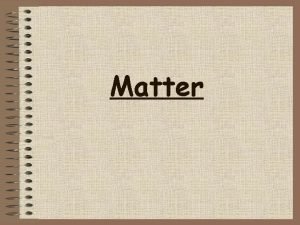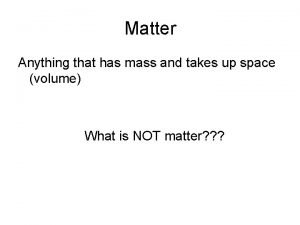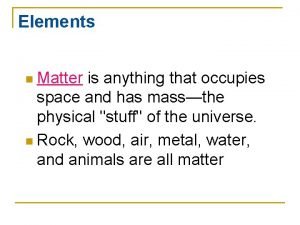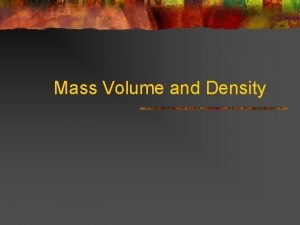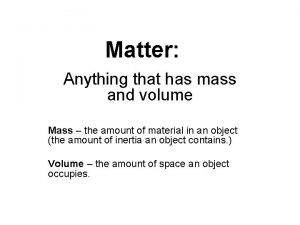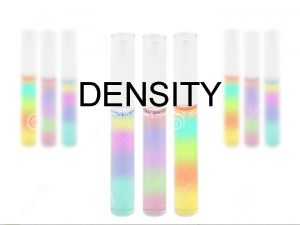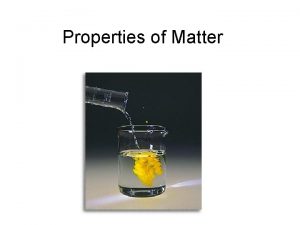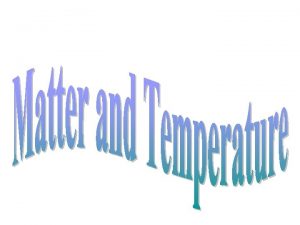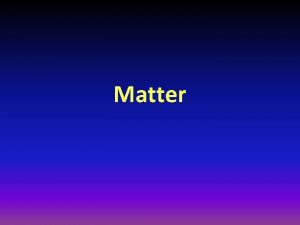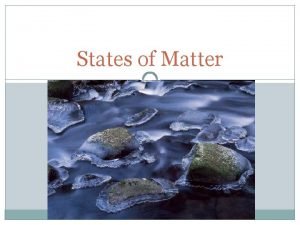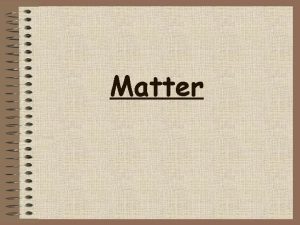Mass Volume Notes Matter Anything that has mass





















- Slides: 21

Mass & Volume Notes

Matter � Anything that has mass and takes up space.

Mass � The amount of matter in an object. �Measured on a scale �Triple-beam balance �Digital

Units for Mass: �Grams – g �Kilograms – kg 1 kg = 1000 g 1 kg = the mass of bottled water 1 kg ~ 2 pounds (lbs) What is my mass in kg? (Your weight ÷ 2 ~ ____ kg) Weight – a measure of the gravitational force exerted on an object


Differences Between Weight & Mass Weight �Measure of the gravitational force on an object �Varies depending on where the object is in the universe �Measured by using a spring scale �Newtons, pounds, kg Mass �Measure of the amount of matter in an object �Always constant for an object no matter where in the universe �Measured by using a balance �Units: g & kg

Volume �How much there is or how much space it takes up. �Cubic centimeters �cm³ �Milliliters �m. L

Method #1 �Solid objects that are regularly shaped. �Use formulas. �Lx. Wx. H �cm³

Example 1 V=Lx. Wx. H �L = 23 cm �W = 12 cm �H = 9 cm V = 23 cm x 12 cm x 9 cm = 2, 484 cm 3

Example 2 Choose a rectangular prism: ______ L = ______cm W = ______ cm H = ______cm V=Lx. Wx. H _____ cm x _____cm = ______cm 3


Volume of a Cylinder (Challenge only) �

QOD #10 �Calculate the volume of a box with sides equal to 50 cm, 40 cm, and 10 cm.

Volume Notes (cont. ) Method #2 �Measure liquids with a graduated cylinder. �m. L �Measure from the bottom of the meniscus (curve).

What is the volume of this liquid? 53 m. L

Measuring Volume Activity Station # 1 2 3 4 5 6 7 8 9 10 Type of Liquid Measurement in m. L

QOD #11 A. Find the volume of an object that measures 4 cm x 5 cm x 10 cm. B. Find the volume of the liquid below. Sketch the drawing in your notebook.

Finding Volume Method #3 – Water Displacement �Volume of irregularly shaped objects. �Measured in cm³ � 1 m. L = 1 cm³

Steps 1. Pour water into a graduated cylinder and record the measure. 2. Carefully slide the object into the water and record the new measure. 3. Subtract the two measures and change the units to cm 3.

QOD #12 �EXPLAIN (write the steps) how to find the volume of the hammer. Include the answer with units in your explanation. (You may use numbered, detailed steps or write it in paragraph form. )

Item Toy car key Ping pong ball Bouncy ball 5 pennies Vol. of water Vol. of only – in ml water w/item - m Subtract – ml Vol. of item in cm³
 Matter is anything that has mass and volume
Matter is anything that has mass and volume This is anything with mass that occupies space.
This is anything with mass that occupies space. Matter is anything that has
Matter is anything that has Mass vs weight
Mass vs weight Matter is anything that
Matter is anything that Anything that has mass and volume is
Anything that has mass and volume is Anything that has mass and takes up space
Anything that has mass and takes up space Anything that takes up space and has mass is
Anything that takes up space and has mass is Matter is anything that takes up space and has
Matter is anything that takes up space and has Anything that takes up space and has mass is
Anything that takes up space and has mass is Matter is anything that has
Matter is anything that has Matter is anything that:
Matter is anything that: Physical properties defintion
Physical properties defintion It is anything that has mass and occupies space
It is anything that has mass and occupies space Matter has mass and occupies space
Matter has mass and occupies space Anything that takes up space and has mass
Anything that takes up space and has mass V=density/mass
V=density/mass Ngoại tâm thu thất chùm đôi
Ngoại tâm thu thất chùm đôi Block nhĩ thất độ 2 type 1
Block nhĩ thất độ 2 type 1 Thể thơ truyền thống
Thể thơ truyền thống Thơ thất ngôn tứ tuyệt đường luật
Thơ thất ngôn tứ tuyệt đường luật Walmart thất bại ở nhật
Walmart thất bại ở nhật
